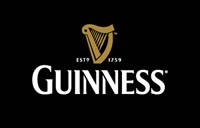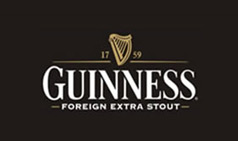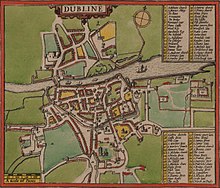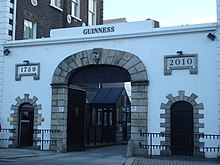
Smithwick's is an Irish red ale-style beer. Smithwick's brewery was founded in Kilkenny in 1710 by John Smithwick and run by the Smithwick family of Kilkenny until 1965, when it was acquired by Guinness, now part of Diageo. The Kilkenny brewery was shut down in 2013 and production of all Smithwick's and Kilkenny branded beers moved to Dublin; parts of the old brewery were later converted into a "visitor experience".

Sir Benjamin Lee Guinness, 1st Baronet was an Irish brewer and philanthropist.

St. James's Gate Brewery is a brewery founded in 1759 in Dublin, Ireland, by Arthur Guinness. The company is now a part of Diageo, a company formed from the merger of Guinness and Grand Metropolitan in 1997. The main product of the brewery is Draught Guinness.

Arthur Guinness was an Irish brewer, entrepreneur, and philanthropist. The inventor of Guinness beer, he founded the Guinness Brewery at St. James's Gate in 1759.

Harp Lager is an Irish lager created in 1959. It is produced by the Guinness Brewery, an Irish brewing company owned by Diageo, Formerly produced at the Great Northern Brewery in Dundalk, it is now brewed at the Guinness Brewery in Dublin. It is a major lager brand throughout most of Northern Ireland, but is now rarely available in the Republic of Ireland outside Dundalk, where most bars offer it on tap.

Brewing in Ireland has a long history. Production currently stands at over 8 million hectolitres, and approximately half the alcohol consumed is beer.

The Liberties is an area in central Dublin, Ireland, located in the southwest of the inner city. Formed from various areas of special manorial jurisdiction, separate from the main city government, it is one of Dublin's most historic working class neighbourhoods. The area was traditionally associated with the River Poddle, market traders and local family-owned businesses, as well as the Guinness brewery, whiskey distilling, and, historically, the textiles industry and tenement housing.

Guinness Foreign Extra Stout (FES) is a stout produced by the Guinness Brewery, an Irish brewing company owned by Diageo, a drinks multinational. First brewed by Guinness in 1801, FES was designed for export, and is more heavily hopped than Guinness Draught and Extra Stout, which gives it a more bitter taste, and typically has a higher alcohol content. The extra hops were intended as a natural preservative for the long journeys the beer would take by ship.

Guinness Storehouse is a tourist attraction at St. James's Gate Brewery in Dublin, Ireland. Since opening in 2000, it has received over twenty million visitors.

The Guinness family is an extensive Irish family known for its accomplishments in brewing, banking, politics, and religious ministry. The brewing branch is particularly well known among the general public for producing the dry stout Guinness Beer. The founder of the dynasty, Arthur Guinness, is confirmed to have had McCartan origins. Beginning in the late 18th century, they became a prominent part of what is known in Ireland as 'the Ascendancy'.
The Great Northern Brewery, on the Carrick Road, Dundalk, County Louth, was an Irish brewery. It was home to Harp Lager, and was formerly owned by Diageo. In 2015 the brewery closed, and production of Harp Lager and other products was moved to St. James's Gate Brewery in Dublin. The site has since been bought by John Teeling, and converted for operation as a distillery, the Great Northern Distillery.
Events from the year 1759 in Ireland.
Arthur Price was Church of Ireland Archbishop of Cashel from 1744 until his death. Previously he had been Church of Ireland Bishop of Clonfert (1724–1730), Ferns and Leighlin (1730–1734) and Meath (1734–1744).

Guinness is an Irish dry stout that originated in the brewery of Arthur Guinness at St. James's Gate, Dublin, Ireland, in 1759. It is now owned by the British-based multinational alcoholic beverage maker Diageo. It is one of the most successful alcohol brands worldwide, brewed in almost 50 countries, and available in over 120. Sales in 2011 amounted to 850,000,000 litres. In spite of declining consumption since 2001, it is the best-selling alcoholic drink in Ireland where Guinness & Co. Brewery makes almost €2 billion worth of beer annually.

St. James' Church is a former Church of Ireland church in James's Street, Dublin, Ireland. Established in 1707, the corresponding parish, which was separated from that of nearby St. Catherine's, was established in 1710. There had been a shrine dedicated to St. James at nearby St. James's Gate, a stopping-off point for pilgrims, since medieval times. It has been proposed that the current church is near to the site of a church to St. James of Compostella which is first referred to in the mid-13th century.

Arthur's Day was an annual series of music events worldwide, originally organised by Diageo in 2009 to promote the 250th anniversary of its Guinness brewing company. It was named after the founder of Guinness brewing, Arthur Guinness.

Sir Mark Rainsford was an Irish Lord Mayor of Dublin and the owner of what was to later become the Guinness Brewery.
Rainsford is an English-language surname, a variation of the toponymic surname Rainford from the village Rainford, Lancashire. Other variants include Raynsford, Rainforth, and Ranford. Notable people with the Rainsford surname variant include:

Arthur Guinness was an Irish brewer, banker, politician and flour miller active in Dublin, Ireland. To avoid confusion with his father, also Arthur Guinness (1725–1803), he is often known as "the second Arthur Guinness" or as Arthur Guinness II or Arthur II Guinness.

James's Street is a street in the Liberties area of central Dublin, Ireland.

















